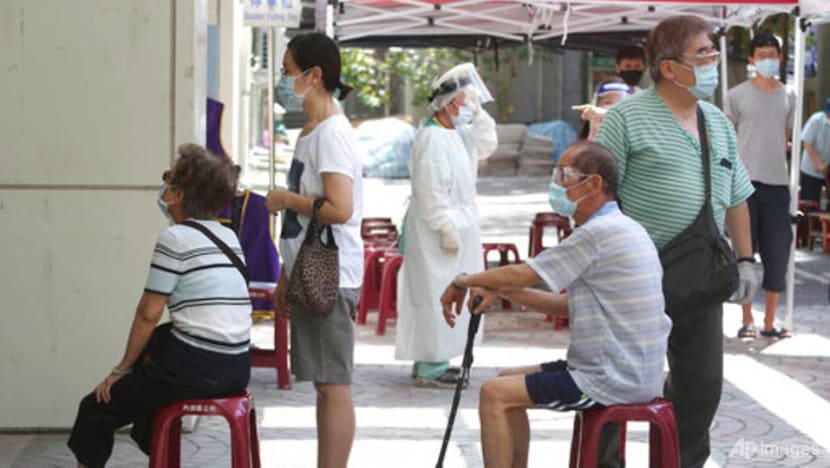Commentary: Omicron outbreak forces Taiwan to re-examine pandemic strategy
While health experts agree that Taiwan can be proud of its pandemic control record, adjusting its approach is a highly challenging exercise, says the Financial Times' Kathrin Hille.

Elderly Taiwanese people wait to receive their vaccinations at a primary school in Taipei, Taiwan. (AP Photo/Chiang Ying-ying)
TAIPEI: There has hardly been a better place to live through the COVID-19 pandemic than in Taiwan.
With strict border controls, meticulous tracking and tracing, and almost universal use of face masks, the island recorded among the lowest infection and death rates in the world and achieved that even without lockdowns.
However, that recipe for success has run its course. The Omicron variant of the coronavirus is forcing Taiwan to move from preventing infections to co-existing with the virus.
As they observe many Western countries allowing the virus to rage through their societies and China stubbornly clinging to a zero-COVID approach, Taiwanese health officials are adamant that there must be a better way.
“Those countries that failed to prevent the spread, or opened up quickly, have to tolerate a high death toll. China is the other extreme, which we will not follow either,” said Chen Chien-jen, an epidemiologist who oversaw Taiwan’s pandemic control effort when he was vice-president until late 2020 and continues to advise the health ministry.
“We want to keep severe cases and deaths to an absolute minimum. Mild cases should be able to live without fear, but we will not release them into the community without any restrictions either,” said Chen. “This is our new Taiwan model.”
While health experts agree that Taiwan can be proud of its pandemic control record, adjusting its approach is a highly challenging exercise. So far, only about four in every 100,000 people in Taiwan have died from COVID-19. That compares with fewer than one per 100,000 in China and 301 in the United States.
GETTING PACE OF REOPENING RIGHT
But that was before Omicron. After slipping into Taiwan in December, the highly contagious variant is spreading quickly. On Friday (Apr 15), the number of new cases soared past 1,000 a day for the first time, and Taiwan has registered a weekly record of 7,097 new cases over the past week.
“Taiwanese are used to getting 100 per cent grades on their pandemic control effort. But this is Omicron, and you have to let go,” said Jason Wang, a professor of paediatrics and health policy at Stanford University. “It is a different problem set, a different phase of the pandemic.”
Even as case rates are climbing, health minister Chen Shih-chung plans to gradually lift an entry ban for non-residents and ease quarantine requirements for returning residents. The biggest difficulty is getting the pace right.
Ho Mei-shang, an adjunct fellow at Academia Sinica, the state scientific research academy, said that Taiwan was relatively lucky to have its outbreak now: Antiviral medication is available, a milder variant is spreading and winter, when more people are prone to sickness, is over. But she stressed the need to avoid overwhelming the medical system.
“It would be a failure if some people even did not get the chance to get into the health facilities,” she said. “We must preserve the capacity of our health system for those who need it.”
Health authorities, therefore, must flatten the curve. “In countries that decided to co-exist with the virus, like the United Kingdom and South Korea, the curve was too steep,” said Chen, the former vice-president.
LOW PROTECTION LEVELS AGAINST COVID-19
That risk matters even more in Taiwan since vaccine shortages delayed its inoculation campaign, and fears of side effects made many elderly hesitant to get vaccinated.
Only 55 per cent of the population have received a booster dose of the vaccine. And while almost 80 per cent have had two shots, that rate is only 71.7 per cent among those over 75 years of age – higher than in China and Hong Kong but low enough to leave a large group of elderly people vulnerable.
“We need two more months to push the booster rate to 70 per cent before we can fully open up,” said Chen.
On the other hand, time is running out because two years without the virus have left Taiwan with natural immunity levels far lower than most other places. Of tests conducted last week, only 1.37 per cent came back positive. In South Korea, which just had a big Omicron outbreak, the rate was 58 per cent.
“If it is still this low in summer, we are in trouble,” said Ho, adding that vaccines alone were not enough to help build herd immunity.
Moreover, experts warn that Taiwan’s health authorities must up their game. “They need to do less contact tracing and more modelling to make sure they have an accurate picture of capacities and timing,” said Wang. “If you want to do something new, you have to give up something old.”













